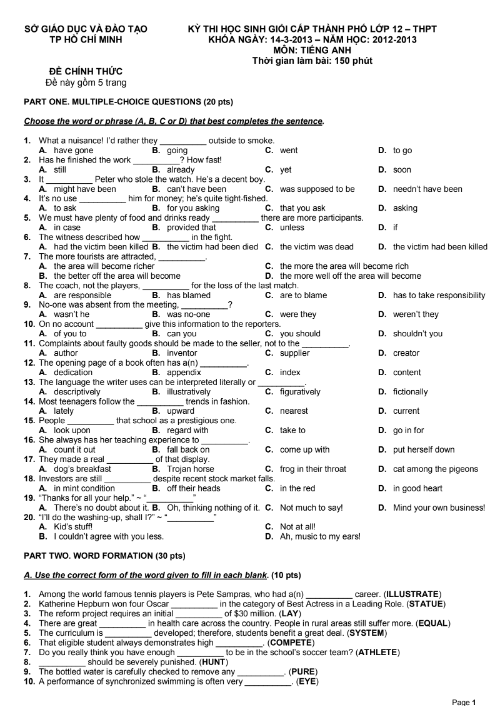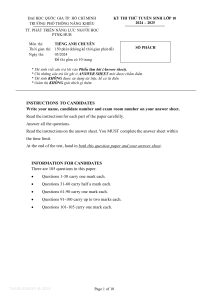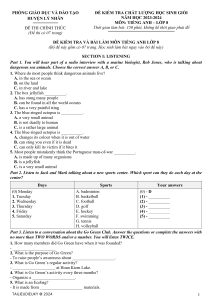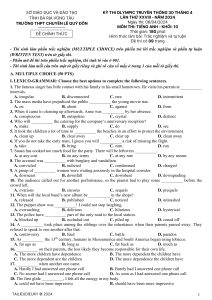Nếu bạn đang chuẩn bị cho kì thi chọn học sinh giỏi môn Tiếng Anh lớp 12 THPT cấp thành phố (TP Hồ Chí Minh) và đang tìm kiếm tài liệu tham khảo, thì Đề thi chọn học sinh giỏi lớp 12 THPT cấp thành phố năm học 2012-2013 môn Tiếng Anh có đáp án là tài liệu không thể bỏ qua.
Tài liệu này được cung cấp trên trang web Tài liệu diệu kỳ và sẽ giúp bạn nâng cao kỹ năng làm bài thi của mình. Đề thi này bao gồm các câu hỏi trắc nghiệm và tự luận, bao phủ các kỹ năng ngôn ngữ cơ bản như đọc hiểu, ngữ pháp, từ vựng, và viết.
Đặc biệt, đề thi cung cấp đáp án chi tiết và lời giải thích, giúp bạn hiểu rõ hơn các câu hỏi và chuẩn bị tốt hơn cho kì thi của mình. Để tìm kiếm tài liệu này trên Google, bạn có thể sử dụng các từ khóa như "đề thi chọn học sinh giỏi lớp 12 THPT môn Tiếng Anh TP Hồ Chí Minh", "tài liệu ôn thi chọn học sinh giỏi Tiếng Anh lớp 12 TP HCM"...
Trích dẫn nội dung "Đề thi chọn học sinh giỏi lớp 12 THPT cấp thành phố (TP Hồ Chí Minh) năm học 2012-2013 môn Tiếng Anh có đáp án":
SỞ GIÁO DỤC - ĐÀO TẠO KỲ THI HỌC SINH GIỎI CẤP THÀNH PHỐ LỚP 12 – THPT
TP HỒ CHÍ MINH KHÓA NGÀY: 4-3-2013 – NĂM HỌC: 2013-2014
MÔN: TIẾNG ANH
Thời gian làm bài: 150 phút
ĐỀ CHÍNH THỨC
Đề này gồm 4 trang
PART ONE. Multiple choice (20 pts)
Choose the word or phrase (A, B, C or D) that best completes the sentence.
1. You’re late again! You ______ your house early enough to avoid the traffic.
A. must have left B. needn’t have left C. should have left D. oughtn’t to have left
2. The house is ______ from school.
A. far B. long C. lengthy D. a long way
3. Had it not been for her patient assistance, we ______ the assignment.
A. couldn’t have finished B. didn’t finish
C. wouldn’t have been finished D. needn’t have finished
4. It’s pointless ______ that stubborn guy.
A. in persuading B. of you persuading C. that you persuade D. to persuade
5. You can win this important match ______ you don’t make silly mistakes.
A. in case B. if only C. unless D. as long as
6. The little boy did nothing but ______ during the party.
A. crying B. cry C. to cry D. for crying
7. Consumers are getting more and more ______.
A. environment awareness B. aware environmental C. environmental aware D. environmentally aware
8. Either the cook or the waiters ______ responsible for the broken plates.
A. were B. was C. has been D. are being
9. Come to my farewell party, ______?
A. do you B. don’t you C. should you D. would you
10. ______ past a water pipe when it fell into another yet again.
A. Hardly the bird flew B. No sooner had the bird flown
C. Barely had the bird flown D. Under no circumstances did the bird fly
11. We are totally in ______ of our father.
A. awe B. respect C. admiration D. affection
12. That young lady has a(n) ______ for making people feel really special.
A. ability B. way C. knack D. ingenuity
13. You should employ a more ______ secretary than the one you currently have.
A. deficient B. effective C. sufficient D. efficient
14. Several passengers received minor injuries when the train unexpectedly came to a ______.
A. delay B. stand C. break D. halt
15. These stiff trainers take weeks to ______.
A. look through B. put up with C. take to D. break in
16. I can’t understand why she ______ the kids most of the time.
A. is down on B. falls back on C. comes down with D. cuts down on
17. There are a few ______ which will help you in painting a room.
A. eyes in the back your head B. cuts and pastes
C. tricks of the trade D. kicks in the teeth
18. Scientists warn that global warming will soon go beyond ______.
A. a comedy of errors B. the border crossing C. the red light D. the point of no return
19. _ A: “Would you mind turning off the TV set?” _ B: “______”
A. Of course! I will. B. Oh, nothing more to say.
C. Another time perhaps! D. I’d rather you did it yourself.
20. _ A: “Shall we go out for a walk?” _ B: “______”
A. A piece of cake! B. Might as well C. Not at all! D. Let me do it!
PART TWO. Word Forms (30 pts)
A. Use the correct form of the word given to fill in each blank. (10 pts)
1. Sports ______ is very often used in advertising nowadays. (image)
2. Disappointed Nadal received the silver plate for the runner-up with ______ smile. (mirth)
3. This is an effective device that ______ your motorbike if anyone tries to steal it. (mobile)
4. That poor old man now suffers from hearing ______. (impair)
5. Don’t you think she is ______? She always looks good in her photographs. (photo)
6. The history of the territory is ______ illustrated in the book. (picture)
7. That fruit is ______; I can’t bear the smell of it. (foul)
8. He decides that after his retirement he will practice ______. (husband)
9. There was a time when we were all young and ______. (ideal)
10. I can get it done by Monday next week at the ______. (early)
B. Put the words given in the correct blanks. You have to use their correct forms to make a meaningful
passage. There are two extra words that you cannot use. (20pts)
structure dominance measure witness employ sanitary
avail dwell fill crowd create world
The earth is (1)______ an urban revolution, as people (2)______ crowd into towns and cities. In 1800 only
five percent of the world’s population were urban (3)______; now the proportion has risen to more than forty-five
percent, and by the year 2015 more people will live in towns and cities than in the countryside. Humanity will, for
the first time, have become a (4)______ urban species.
Though the world is getting more (5)______ by the day, absolute numbers of population are less important
than where people concentrate and whether these areas can cope with them. Even densities, however, tell us
nothing about the quality of the (6)______ – roads, housing and job (7)______, for example – or the availability of
crucial services.
The main question, then, is not how many people there are in a given area, but how well their needs can
be met. Density figures have to be set beside (8)______ of wealth and employment, the quality of housing and the
(9)______ of education, medical care, clean water, (10)______ and other vital services.
PART THREE. CLOZE TESTS (90 pts)
Read the passage and choose the best option (A, B, C or D) for each blank space.
PASSAGE A
To make a career and (1)______ a living is very important in life. You have to be very (2)______ in deciding
a career and you can find help doing that over here.
Career choice made turns the life of a person in full (3)______. Although salaries (4)______, if you get into
a field which you love, you will be happy all your life. On the other hand if you just work for those extra (5)______
alone, you have to regret a lot.
Many experts predict the (6)______ of new roles in the coming years with specialized educational courses
(7)______ to serve the industry. The job market has become very (8)______ over the years and you have to be
very careful while deciding your job role or else a course that qualifies you for it.
You have got a wide (9)______ of options to choose your career from, which is a(n) (10)______ of
globalization and, it is as important to know how the career tests for each course looks like. So, it’s imperative that
you need career (11)______ from experts to scrap off all the misconceived (12)______ to opt for a job that suits
your skills.
The educational qualifications provide a (13)______ which lets you (14)______ onto the desired roles and
hence guidance for that too is quite necessary along with proper (15)______ as the course and the institution which
offers the course is to be evaluated based on various factors.
1. A. for B. thus C. so D. then
2. A. reclutant B. offensive C. complacent D. objective
3. A. length B. term C. measure D. degree
4. A. matter B. raise C. rise D. account
5. A. costs B. bucks C. expenses D. spendings
6. A. disappearance B. finding C. emergence D. development
7. A. aiming B. running C. initiating D. evolving
8. A. stagnant B. dynamic C. depressing D. perilous
9. A. variation B. range C. coverage D. curve
10. A. impact B. root C. motive D. obstacle
11. A. prospect B. choice C. counselling D. advancement
12. A. connotations B. passions C. visions D. notions
13. A. stage B. platform C. arena D. ring
14. A. look B. cascade C. embark D. call
15. A. coaching B. facilitating C. handling D. exploiting
Fill in each of the blanks in the following passage with ONE suitable word.
PASSAGE B
Nowadays, people depend on unlimited energy to power their everyday lives. A wide (1)______ of energy-
run devices and modern conveniences are (2)______ for granted, and although it may seem that we will never be
in (3)______ of living without those conveniences, the fact is that many (4)______ of energy are dwindling rapidly.
Scientists are constantly (5)______ for new sources of power to keep modern society (6)______. Whether future
populations will continue to (7)______ the benefits of abundant energy will depend on the (8)______ of this search.
Coal, oil, and natural gas supply modern civilization with most of (9)______ power. However, not only
(10)______ supplies of these fuels limited, but they are a major source of pollution. If the energy (11)______ of the
future are to be met without seriously (12)______ the environment, existing alternative energy sources must be
improved or (13)______ explored and developed. These (14)______ nuclear, water, solar, wind, and geothermal
power, as well as energy from new, nonpolluting types of fuels. Each of these (15)______, however, has
advantages and disadvantages.
PASSAGE C
According to some recent research, people who drink moderately, (16)______ regularly, quit smoking and
eat five servings of fruit and vegetables each day live on (17)______ 14 years longer than people who adopt
(18)______ of these behaviors. Overwhelming evidence has shown that these things (19)______ to healthier and
longer lives. The new study actually quantified their combined impact. These results may provide further support
for the idea that (20)______ small differences in lifestyle may (21)______ a big difference to health in the population
and encourage behaviour change.
Between 1993 and 1997 the researchers questioned 20,000 healthy British men and women about their
lifestyles. They also tested every participant's blood to (22)______ vitamin C intake, an indicator of how
(23)______ fruit and vegetables people ate. Then they assigned the participants – (24)______ 45-79 – a score of
between 0 and 4, giving one point for each of the healthy behaviours. After allowing for age and other (25)______
that could affect the likelihood of dying, the researchers determined people with a score of 0 were four times as
likely to have died, particularly from cardiovascular (26)______. The researchers, who tracked deaths among
the (27)______ until 2006, also said a person with a health score of 0 had the same (28)______ of dying as
someone with a health score of 4 who was 14 years older.
The lifestyle change with the biggest benefit was giving up smoking, which led to an 80 percent
(29)______ in health, the study found. This was followed by eating fruits and vegetables. (30)______ drinking and
keeping active brought the same benefits.
PART FOUR. Reading Comprehension (40 pts)
Choose the item (A, B, C, or D) that best completes the unfinished statement about the passage.
PASSAGE A
The development of jazz can be seen as part of the larger continuum of American popular music, especially
dance music. In the twenties, jazz became the hottest new thing in dance music, much as ragtime had at the turn
of the century, and as would rhythm and blues in the fifties, rock in the fifties, and disco in the seventies.
But two characteristics distinguish jazz from other dance music. The first is improvisation, the changing of
a musical phrase according to the player's inspiration. Like all artists, jazz musicians strive for an individual style,
and the improvise or paraphrase is a jazz musician's main opportunity to display his or her individuality. In early
jazz, musicians often improvised melodies collectively, thus creating a kind of polyphony. There was little soloing
as such, although some New Orleans players, particularly cornet player Buddy Bolden, achieved local fame for
their ability to improvise a solo. Later the idea of the chorus-long or multichorus solo took hold. Louis Armstrong's
instrumental brilliance, demonstrated through extended solos, was a major influence in this development.
Even in the early twenties, however, some jazz bands had featured soloists. Similarly, show orchestras and
carnival bands often included one or two such "get-off" musicians. Unimproved, completely structured jazz does
exist, but the ability of the best jazz musicians to create music of great cohesion and beauty during performance
has been a hallmark of the music and its major source of inspiration and change.
The second distinguishing characteristic of jazz is a rhythmic drive that was initially called "hot" and later
"swing". In playing hot, a musician consciously departs from strict meter to create a relaxed sense of phrasing
that also emphasizes the underlying rhythms. ("Rough" tone and use of moderate vibrato also contributed to a hot
sound.) Not all jazz is hot, however, many early bands played unadorned published arrangements of popular
songs. Still, the proclivity to play hot distinguished the jazz musician from other instrumentalists.
1. The passage answers which of the following questions?
A. Which early jazz musicians most influenced rhythm and blues music?
B. What are the differences between jazz and other forms of music?
C. Why is dancing closely related to popular music in the United States?
D. What instruments comprised a typical jazz band of the 1920's?
2. Which of the following appeared before jazz as a popular music for dancing?
A. Disco B. Rock C. Rhythm and blues D. Ragtime
3. According to the passage, jazz musicians are able to demonstrate their individual artistry mainly by?
A. creating musical variations while performing B. preparing musical arrangements
C. reading music with great skill D. being able to play all types of popular music
4. Which of the following was the function of "get-off" musicians (line 12)?
A. Assist the other band members in packing up after a performance
B. Teach dance routines created for new music
C. Lead the band
D. Provide solo performances in a band or orchestra
5. The word cohesion in the passage is closest in meaning to
A. sorrow B. fame C. unity D. vibration
6. The word initially in the passage is closest in meaning to
A. at first B. shortly C. alphabetically D. in fact
7. The word consciously in the passage is closest in meaning to
A. carelessly B. easily C. periodically D. purposely
8. The word unadorned in the passage is closest in meaning to
A. lovely B. plain C. disorganized D. inexpensive
9. Which of the following terms is defined in the passage?
A. "improvisation" (line 4) B. "polyphony" (line 7) C. "cornet player” (line 8) D. "multichorus” (line 9)
10. The topic of the passage is developed primarily by means of
A. dividing the discussion into two major areas B. presenting contrasting points of views
C. providing biographies of famous musician D. describing historical events in sequence
PASSAGE B
The importance of strength in many sports is undeniable. It is so important that many university and
professional teams now hire a specialized coach who only attends to the development of strength in athletes. It is
interesting to note that no such specialist is hired to attend to the other components of physical fitness. We have
yet to see a cardiovascular coach, a coach who attends to developing fitness of the heart and blood vessels, hired
by universities or professional teams. This situation raises the question of the relative importance of each of these
two components, strength training and cardiovascular training, to the other. Does the strength coach develop the
cardiovascular system by prescribing a program to increase muscle fiber?
It is theoretically possible to design a weight-lifting program in which the resistance is so low and the
repetitions so numerous that it provides the cardiovascular benefits of a running program. Therefore, if you view
weights as a way to overload muscles, you can imagine a continuum of programs that emphasize cardiovascular
benefits on the one extreme and strength on the other. The practical truth of the matter is that most coaches are
primarily concerned with pure strength. Therefore, the athlete has to work on the end of the weight-overload
continuum that promotes little, if any, cardiovascular benefit. In fact, one study has found that a high-intensity
strength program reduced mitochondrial density (density of the cellular structures that produce energy in the muscle
fiber) per unit of muscle. The athletes increased muscle mass, so they did not eliminate mitochondria presumably,
but the fact remains that the oxidative capacity, the ability to use oxygen in the synthesis of energy, was not
promoted. Oxidative capacity would usually improve in programs that stress cardiovascular conditioning.
Neither increased blood flow nor increased mitochondrial density (both indicators of oxygen extraction) occur with
strength training.
Obviously, there is nothing wrong with training athletes to gain strength, but in most strength programs
cardiovascular improvements are not made. Therefore, for athletes, who require both strength and cardiovascular
conditioning, both components must be trained independently.
11. What is the main point of the passage?
A. College and professional teams do not need specialized coaches.
B. Strength training should be replaced by cardiovascular training.
C. Cardiovascular training is more difficult than strength training.
D. Athletes need both strength and cardiovascular training.
12. The word prescribing in the passage is closest in meaning to
A. accepting B. assigning C. releasing D. expecting
13. Under which of the following conditions can a weight-lifting program provide cardiovascular benefits?
A. When the weights are very heavy B. When the weights are lifted very slowly
C. When lifting a heavy weight overtires the musclesD. When light weights are lifted a large number of times
14. The word it in the passage refers to
A. cardiovascular system B. muscle fiber C. weight-lifting program D. resistance
15. Why does the author mention running?
A. To give an example of the benefits of strength training
B. To demonstrate what a typical weight program includes
C. To give an example of an activity that provides cardiovascular conditioning
D. To demonstrate the importance of oxygen extraction
16. The word promotes in the passage is closest in meaning to
A. agrees with B. advertises C. designs D. contributes to
17. Which of the following is an important direct result of cardiovascular training?
A. Improved oxidative capacity B. Increased muscle fiber
C. Decreased mitochondrial density D. Increased body weight
18. The word indicators in the passage is closest in meaning to
A. kinds B. signs C. problems D. requirement
19. The word components in the passage is closest in meaning to
A. elements B. effects C. perspectives D. values
20. Which of the following policies would the author be most likely to support?
A. Sports teams should increase their strength-training programs.
B. All athletes should be able to choose the kinds of training they prefer.
C. Sports teams should provide improved cardiovascular training.
D. All athletes should avoid strength training in order to avoid injury.
PART FIVE: SENTENCE TRANSFORMATION (20 points)
Rewrite each sentence in such a way that it means almost the same as the one printed before it. Use the
word in brackets without making any change to it.
1. The signer’s popularity suffered as a result of the scandal. (effect)
The scandal _________________________________________________ 2. Customs officials are stopping more travelers than usual this week. (searched)
An increased ________________________________________________ 3. The teachers agreed to introduce the new method. (bring)
There was __________________________________________________ 4. Those stores will accept a credit card instead of cash. (alternative)
It is _______________________________________________________ 5. They say he has been to prison several times. (reputed)
He ________________________________________________________ 6. They decided not to go by boat because they thought they would be seasick. (fear) ___________________________________________________________ 7. I have two brothers; they do not work as a teacher. (whom)
I have _______________________________________________________ 8. Right after the teacher finished the question, Katie gave an excellent answer. (came)
No sooner ____________________________________________________ 9. They are archrivals, but they are friendly to each other. (way)
In spite ______________________________________________________ 10. You should do anything to reduce smoking. (lenghths)
It is _________________________________________________________
THE END.
SUGGESTED KEY
MULTIPLE CHOICE
1. C
2. D
3. A
4. D
5. D
6. B
7. D
8. A
9. D
10. C
11. A
12. C
13. D
14. D
15. D
16. A
17. C
18. D
19. D
20. B
WORD FORM
1. imagery
2. mirthless
3. immobilizes/immobilises
4. impairment
5. photogenic
6. pictorially
7. foul-smelling
8. husbandry
9. idealistic
10. earliest
11. witnessing
12. worldwide
13. dwellers
14. predominantly
15. crowded
16. infrastructure
17. creation
18. measurements
19. availability
20. sanitation
CLOZE TESTS
PASSAGE A
1. B
2. D
3. B
4. A
5. B
6. C
7. D
8. B
9. B
10. A
11. C
12. D
13. B
14. C
15. A
PASSAGE B
1. range
2. taken
3. danger
4. supplies/sources
5. searching
6. running
7. enjoy
8. success
9. its
10. are
11. demands
12. harming
13. further
14. include
15. alternatives
PASSAGE C
16. exercise
17. average
18. none
19. contribute
20. even
21. make
22. measure
23. much
24. aged
25. factors
26. disease(s)
27. participants
28. risk
29. improvement
30. Moderate
READING COMPREHENSION
1. A
2. C
3. D
4. A
5. C
6. A
7. B
8. A
9. A
10. A
11. D
12. B
13. D
14. C
15. C
16. D
17. A
18. B
19. A
20. C
SENTENCE TRANSFORMATION
1. The scandal had negative effect on the singer’s popularity.
2. An increased number of travelers are being searched this week.
3. There was an agreement among the teachers to bring in the new method.
4. It is a credit card not cash as an alternative that those stores will accept.
5. He is reputed to have been to prison several times.
6. They decided not to go by boat for fear of being/getting seasick.
7. I have two brothers, neither of whom work as a teacher.
8. No sooner had the teacher finished the question than Katie came up with an excellent answer.
9. In spite of being archrivals, they treat each other in a friendly way.
10. It is smoking that you should go to any lengths to reduce.



